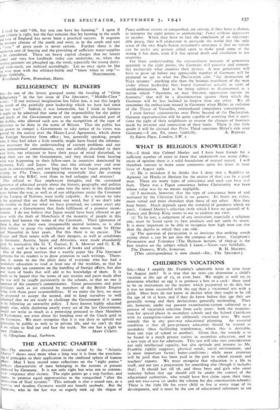AGRICULTURAL FOLLY
SIR,—Will you allow me, as a practical farmer of nearly 4o year!' experience, to endorse every word of your correspondent, Mrs. Pock, in your issue of August 22nd? It seems to me the official world is completely losing its sense of proportion with regard to pasture-land on our farms. They are rather like the man who, because one gins of whiskey or champagne does him good, must needs sit down and finish the bottle. Because some worn-out pastures very definitelt needed ploughing up (and we. have ploughed up four million acres of pasture) it is now proclaimed that the great ideal is to plough up every pasture regardless of its quality, the situation of the farrn, whether the whole balance of the farm is thrown out, the climate the rainfall or other considerations.
I write as one who is not a dairy-farmer but a feeding farmer (and meat is as essential as any other sort of food—witness the demands of those in our heavy industries)—and as one who has for the last 28 years kept roughly two-thirds of his farm under arable cultivation- but a proportion of grass is essential on every farm, and the so-called " yardstick " which the War Agricultural Committees are now made to apply is foolish. I was seriously told that only one acre of pasture was to be allowed a fatting bullock—the rate of stocking allowed Or the best grazing lands on high Leicestershire but in all other part; of England an impossible ideal.
I doubt if the best results are arrived at on most English farm (exceptional conditions of course excepted) where the farm has much more than half its extent under arable cultivation, to exceed two-thirds throws practically the whole farm out of balance. On a rearing farm half should be ample. I say this—with the equal opinion gained from experience—that in most cases an all-grass farm is a mistake as it leads to too much dependence on imported feeding-stuffs and often the indifferent wintering of some of the stock. About half and half is probably on many soils the ideal. On some high-lying farms. one-third arable to two-thirds pasture is the best proportion, while on other soils more suited to arable cultivation the proportion may to as high as two-thirds arable to one-third pasture. Beyond that. except for special conditions, it is undesirable to go—even in wartime.
A supply of store cattle, fresh heifers for the dairy or fresh bullocks to the grazier is an essential and as much to the nation's interest as a supply of wheat or potatoes and is much less at the mercy of the weather and makes less call on the supply of labour. The result of the " Oats and potatoes " policy now so popular with the authorities has led to the almost complete disappearance of English butter ant cheese, an enormous reduction in the egg-supply and a large reduc tion in the meat-supply of the country. These things are as important as cereals and less subject to weather-risks. Because the all-grass farm run on imported feeding-stuffs and used mainly as an exercising ground for the stock is from a national point of view uneconomic it does not follow that the remedy is to plough up every pasture in sight, and the present official attitude of the authorities, "The better the pasture the more desirable it is it should be ploughed up," is sheer folly. Whatever scientists may say every practical fame' knows that though " to break a pasture may make a man, to make a pasture will break a man,". or, as I once heard it better put, "nkrl fool can plough up a good pasture in a week ; a wise man may COn be able to remake it in his lifetime."
The extravagant prices for dairy cows, and for young heifer stock shows the condition things are getting into. We have ploughed up four million acres of pasture of one sort and another and probably in many cases that was right, but because that is true let officialdom keep its head and not destroy every pasture in the countryside. Mit is an essential food, and in the main dairying and pasture go together, for the rearing of young stock grass is essential and there is mud land that is better employed that way than any other.
Oats and potatoes will not feed a population used to meat, butter: eggs and cheese, all goods which take up more shipping-space that cereals. Let us be sure that in increasing the supply of one we are not doing more serious harm in decreasing the supply of the other. A self-supporting farm is an ideal. Those that approach it are oho some of the best farmed farms in the country, but an all-arable faro can no more be self-supporting than an all-grass farm and there are hundreds of acres in the country which are best used to breed and to supply the stock to the better farms.
I shall be told "Oh, but you can have ley farming." I agree if four climate is right, but the fact remains that ley farming in the south and east of England has never been a practical success. It requires ;he moister climate of the north and west, as in the south and east " take " of grass seeds is never certain. Further there is the :normous cost of fencing and the providing of sufficient water-supplies in be considered. These are heavy capital charges that no tenant farmer and very few landlords today can undertake, so, when the misting pastures are ploughed up, the stock, especially the young dairy- Ind store-stock, are reduced accordingly. Let us once again be like he wise man with the whiskey-bottle and " know when to stop."—



























 Previous page
Previous page